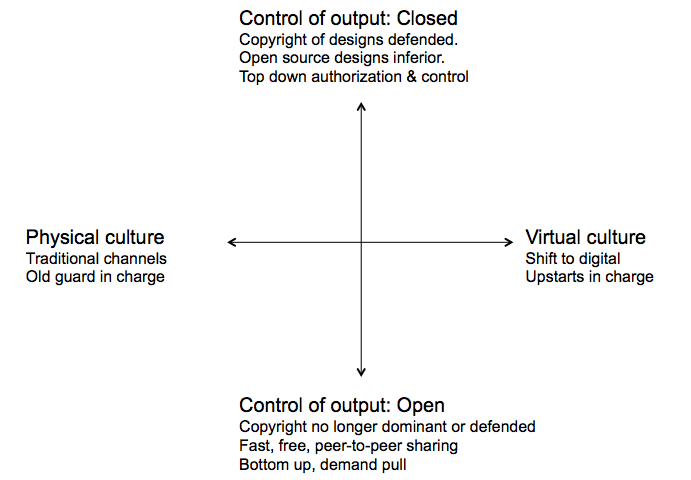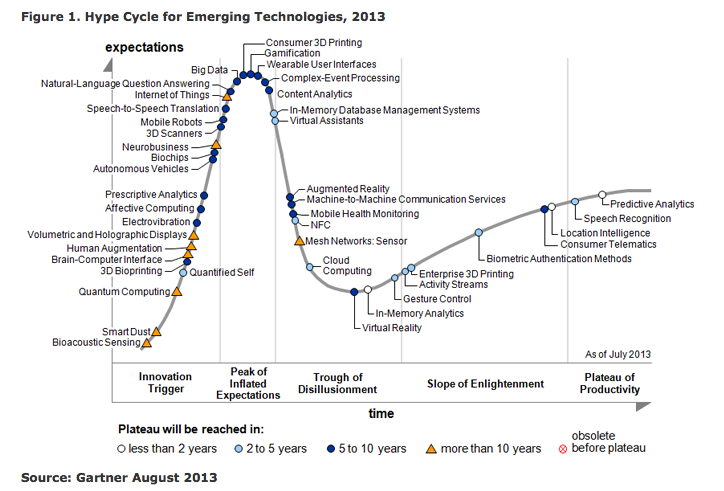Or, perhaps, dream drunk, implement sober.
Monthly Archives: March 2014
3D Print Futures
Just been playing around with a scenario matrix for the future of 3D printing. The vertical axis seems obvious – whether control remains closed or opens up (i.e. is the copyright of designs vigorously defended or opened up). The horizontal axis is much less clear and currently seems to close to the vertical (you could argue that both are identical, which is useless). Anyway, it’s a start.
Russian expansionism
Just spotted this at the end of my book Future Files – 2012 update, page 302.
“Russia will become more nationalistic (and go outward militarily).”
This wasn’t my idea. It stems from reading The Next 100 Years by George Friedman. His chapter on Russia 2020 is worth a look. His general argument is that major conflicts tend to repeat themselves and therefore history can indeed be a good guide to the future.
” The Russians are extremely well aware that they are facing a massive demographic crisis. Russia’s current population is about 145 million, and projections for 2050 are for between 90 million and 125 million. Time is working against it. Russia’s problem will soon be its ability to field an army sufficient for its strategic needs. Internally, the number of Russians compared to other ethnic groups is declining, placing intense pressure on Russia to male a move sooner rather than later.”
I also liked his thought that you need to look at the psychology driving national politics. In the case of Russia (and France and the UK) it’s all about the loss of empire and a desire to regain influence. Anyone for the Rise of the Fifth Reich?
Technology hype cycles
Just finishing off something on 3D printing (bigger than the internet or just a load of plastic junk?) and thought I’d share this with you. As you can see, consumer 3D printing is at the top of the hype cycle and about to plunge into the trough of disillusionment. Not sure if Gartner have done a 2014 update yet, but it doesn’t appear so.
Brainmail issue 89 is alive
Just to let you know that that brainmail just went up. If you don’t know about it brainmail is a digital cabinet of curious facts and wonderful ideas that’s been feeding hungry minds since 2004. It’s still free so why not sign up here.
http://brainmail.nowandnext.com/
Here are some bits from the current use.
According to OK Cupid, an online dating site, men
exaggerate their height by an average of two inches and
expand their income by an average of 20% when posting
profiles of themselves.The older the person is the older their
photograph tends to be too. Ladies (and Gentlemen)
you have been warned.
On almost every measure that matters (longevity, literacy,
infant mortality, wars, extreme poverty etc.) life is getting
better, not worse, for the vast majority of the world’s
people. For example, in 1990, slightly over 40% of the
population in developing countries (1.9 billion people)
were living in conditions of extreme poverty (then defined
as living on less than $1 per day). By 2000, this number
had shrunk to 21% (1.2 billion).
People that text more than 100 times per day are 30% less
likely to think that being ethical is important, according
to a study by the University of Winnipeg. (I don’t really
understand this either).
1/3 of the National Health Service’s 39,409
consultants were born outside the UK.
Of 16 female US senators in 2010 aged 56-74, not one had visible grey hair and neither did 90% of women in the House of Representatives.
Issue links:
http://brainmail.nowandnext.com/brainmail_issue89.txt
And for smartphone users:
http://brainmail.nowandnext.com/brainmail_issue89i.txt
Women (not) in the movies
A report called ‘It’s a Man’s (Celluloid) World’, looking at the 100 biggest grossing US movies of 2013, found that men played around 70% of onscreen speaking roles, 71% of major characters were men and 85% of characters deriving the plot were male.
A copy of the report can be found here.
Things you should be able to do in your local library
Sorry, got caught up with some work and then somehow managed to open the car door onto my head, which confused me a bit. How is this even possible? Still rather sore 3 days on. Anyway, libraries…
Following on from my lecture in the Netherlands, here is a list of things that I feel you should be able to do in a local library. With acknowledgement to Thomas Frey from the Da Vinci Institute in the USA, who also spoke at the conference.
Borrow books
Read books
Borrow music
Listen to music
Borrow films
Watch films
Borrow toys
Donate toys
Borrow a meeting room
Borrow clothes (especially work clothes for interviews)
Donate unwanted clothes
Borrow a pet
Borrow a heater
Borrow a fridge
Borrow a computer, iPad, Kindle etc.
Borrow an expert in something
Eat a meal (especially if you can’t afford to eat)
Sit quietly all day without being asked to leave or buy something
Play with a 3D printer
Build Lego
Learn a language
Learn how to use technology
Find yourself
Improve yourself
Photocopy or scan things
Meet people
Engage in conversation with people that live alone
Exchange knowledge, information and wisdom
Get out of the cold and wet (sun in Australia)
Gain access to pay-walled information – for free
Look up your family history
Access government services
Have a health check
Learn to read
Listen to stories
Ask questions
Use a telescope (yes, at night)
Use the (very clean) bathroom
Attend a local event
Paint or draw
Swap plant seeds
Exchange recipes
Please add some more things under comments…
Why people use libraries
So it turns out that one of the most popular questions asked of public librarians in the Netherlands is….”where are the toilets?” Joking aside, the cleanliness and quality of bathrooms isn’t a bad USP. With McDonald’s it’s one of the major reasons women with small children visit. Showers? Why not. If public libraries are becoming freelance spaces this would not be a bad thing to add. Off to the airport – where there is apparently a library. More on what you might be able to do in a library in the future tomorrow.
Weedy idea
Off to Amsterdam today to talk with some Dutch library folks, but continuing with the first chapter of my new book so highly engaged with what’s going on around me as I may be able to use it in some way. For example, today I was told to be careful because the escalator was coming to an end. Really. Do people not notice? Maybe if they fell off they’d be more observant next time?
Yesterday I was in London and came across a cafe with a sign in the window offering “weeds of nutritional significance.” I’m OK with this (it’s a little too fashionable for its own good, but I get the connections). However, the sign went on…”Weeds of nutritional significance, from Australia.” You mean they’ve flown some weeds from Australia to London so that people eating a sandwich can feel more connected to the land in an organic, bio-dynamic, slow food kind of way? And the fuel needed to fly those weeds 10,000 miles is what? If you’re going to eat weeds at least make them local.
Some thoughts on retail
I was asked recently to briefly say something about IT, retail, humans and the future.
The first two are easy. The last two less so. What do we mean by future? I met a science fiction writer called Lavie Tidhar once and he defined the future as being “when things get weird.” In that case I’d suggest that the future is now. $19 billion for Whats app is weird. $19 billion is 10% of Facebook’s valuation. Last year Whats app turned over just $20 million. $19 billion is a lot of money for a messaging app and a long list of names.
Anyway, putting that bubble to one side, here are a few thoughts about retail.
My first thought is a general one. Online is going to grow significantly. Having said this I think there are limits, caused more by psychology than technology.
What I expect to happen is that retail will polarise between high tech and high touch. Habitual, commodity retail will become increasing automated and virtual. There’ll be more mobile shopping, more personalisation and more predictive sales and marketing, based not only on past buying behaviour, but on customer location and mental state. In short, where are people right now, what are they doing, and what might they be persuaded to do next?
They’ll also be more personalisation in the sense that homepages and virtual stores could be different for each individual customer, either due to historical buying patterns or due to facial and verbal recognition. What I mean by this is that if privacy isn’t an issue – and it may well be – it’s easy to instantly alter a home page or virtual store layout based upon general observations retailers can make about a person on a particular device. Cameras and microphones linked to software can, for instance, judge not only age and gender, but emotional state too. I believe Microsoft and Toyota have been looking at emotionally aware machines for a while.
And we’ll shop verbally, like we do in the real world, not by typing in words or ticking boxes on a website. Online retail will have more of a verbal interface. Ultimately, we might even order things by thinking about them, but that’s a long way off and definitely weird.
I’d expect speed and convenience would continue to play a vital role in retail so investment will shift away from stores to supply chains and warehousing. Supply chains will shorten, partly to increase speed, but also to improve agility and resilience in the face of volatility and to respond to customer demands for localisation.
Warehousing will become a key battleground, because the focus will be on how fast something can be dispatched. This links to delivery and I’d expect that Big Data and social media will play a role here, working out when the optimal time to deliver goods to customers is and making adjustments in real time.
As for physical stores, and I don’t see these going away any time soon.
Physical stores, be they out of town Big Box stores, seriously smart vending machines or tiny convenience stores, will still have a role to play because in many instances they will remain the most convenient option. For example, this afternoon a significant number of people (especially those aged 18-24) will have no idea what they will eat for dinner tonight and haven’t bought anything yet either. How do you solve that online? You can’t – unless you start to use drop boxes or local convenience stores as collection points. Or perhaps you could have self-driving food trucks containing the most popular dinner options constantly circling cities awaiting orders.
We also shouldn’t forget that a substantial percentage of shopping, especially in supermarkets, is impulse and impulse is related to physical store design, physical packaging design and serendipity.
You can have virtual stores with graphics reminiscent of the very best computer games, you can have other customers wandering through a virtual store in real time, haptic gloves to touch virtual products and aroma pods to virtually smell things too, but it’s not quite the same. The machines can’t smile or ask how your day has been on any meaningful level.
I’d expect sales assistants to disappear in shops like supermarkets soon, and cash registers and checkouts might start to vanish too. We can ask questions via our mobile devices and we can pay for them when we exist a store if the products carry an electronic tag that talks to our mobile or wearable device at the exit. No more shop lifting.
But retail is social, not only the sense of social media, but in a more profound way. Women, in particular, like to forage and chatter in shops in groups and while both can be done online, it’s not an especially rich experience. Add in the sensory and tactile nature of many products, especially luxury goods and specialist retail, and many aspects of the future of retail start to look much like its past.




